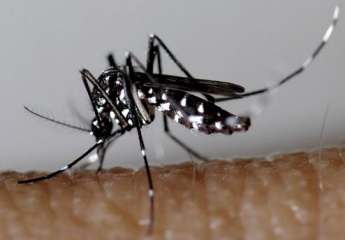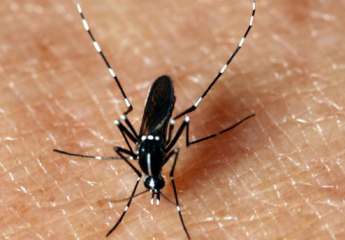
The tiger mosquito
This invasive species has spread to almost everywhere on the planet; only Antarctica is currently spared. This meteoric expansion, mainly linked to international trade (especially in tyres), has made it one of the world's most invasive species due to its ability to adapt to regions with cold winters. In metropolitan France, in 2025, the tiger mosquito is found in 81 French départements.
Tiger mosquitos can transmit viruses such as dengue, chikungunya and Zika to humans. They are therefore subject to reinforced surveillance by the French authorities, in particular through the Signalement-moustique (“mosquito alert”) website (in French).
How can you tell a tiger mosquitos from other species of mosquitoes ?

Noiseless and diurnal : in contrast with the common mosquito (Culex) which tends to bite at night and which makes noise when flying, the tiger mosquito is diurnal, in other words it bites during the day (mainly in the morning and the evening), and it makes no noise.
A small mosquito : The name "tiger mosquito" can easily be misleading. This species of mosquito is actually quite small, less than 5 mm in length (smaller than a 1 centime coin)!
Black and white stripes : Here again, its name is misleading since the tiger mosquito is not yellow and black but white and black. It is also characterised by the presence of a white dorsal line along its thorax. Its legs also have stripes.
Can tiger mosquitos transmit disease-causing pathogens ?
Certain mosquitos - less than 400 of the highly biodiverse mosquito family’s 3500 species - can transmit pathogens (viruses, bacteria, parasites). In order to spread disease, the mosquito must first become infected through feeding on the blood of an infected human or animal host. Once infected, the female mosquito (never the male) can then transmit the pathogen to a healthy subject when feeding on their blood. It takes several days for a mosquito to become infectious, i.e. for the virus to cross the digestive barrier, multiply and pass into the mosquito's saliva. A mosquito does not directly inject blood it has taken from a previous host, and is unable to transmit just any pathogen.
The tiger mosquito is a vector for many different viruses including those responsible for dengue fever, Zika and chikungunya. To date, these viruses are not in active circulation in metropolitan France. However, the occurrence of secondary - or “autochthonous” - cases (contracted without travel) in metropolitan France are a very real risk. These autochthonous cases can occur following “imported” cases of people carrying the virus returning from abroad who can then transmit the virus to another person through a tiger mosquito bite.
In metropolitan France, other mosquitos are mainly simply an unpleasant nuisance.
Where do they breed ?
Particularly resistant and well-adapted to the human environment, tiger mosquitos prefers suburban environments and very dense urban areas. The females lay their eggs in all kinds of artificial water recipients and reservoirs: vases, pots, drums, rainwater collection tanks, gullies, rain gutters and drains, raised terraces, old tyres, etc. A female mosquito can lay several hundred eggs at a time, and the females of certain species can breed several times throughout their life, so it is essential to eliminate places where they can lay their eggs.
Moreover, the tiger mosquito are an “exophilic” species, meaning that they live mainly outdoors, although it may enter dwellings to bite humans.
What can I do to prevent tiger mosquitos from proliferating ?
To avoid the spread of this species by destroying egg-laying sites, it is essential to:
- change the water in vases regularly, empty or remove the saucers under flowerpots... or fill them with sand to keep them damp while avoiding stagnant water;
- put away buckets, pails, gardening equipment, games and any other recipients in an area which is sheltered from rain;
- cover rainwater collection tanks with a mosquito net or cloth;
- clean gutters to facilitate proper drainage.
How and why should I report a tiger mosquito sighting ?
You can also help with tiger mosquito monitoring by reporting a sighting at the Signalement-moustique website here (in French).
The website was created in 2014 at the request of the French Health Ministry and has been managed by ANSES since 2018. It aims to provide early detection of tiger mosquitos in France. Thanks to reports by private individuals, the list of communities in metropolitan France that have been colonised by the tiger mosquito is updated on a regular basis. The data collected enables the health authorities to set up suitable targeted control measures should an arboviral disease such as Zika, dengue fever or chikungunya be detected.
Before submitting a report on the Signalement-moustique website (in French), you will need either a photo of the tiger mosquito or a specimen good enough to allow identification (to be sent to the mosquito control operator in your area, if applicable).
Once this condition has been met, you will need to answer the three questions below to confirm that it is indeed a tiger mosquito. Then, if applicable, you will be able to add your report.
-
Is the mosquito small?
 The name "tiger mosquito" can easily be misleading. This species of mosquito is small, less than 5 mm in length (smaller than a 1 centime coin)!
The name "tiger mosquito" can easily be misleading. This species of mosquito is small, less than 5 mm in length (smaller than a 1 centime coin)! -
What colour is it? Here again, its name is misleading since the tiger mosquito is not yellow and black but white and black. It is also characterised by the presence of a white line along its thorax.
- Does the mosquito have five bands of white scales on its back legs, and a white dorsal stripe on its thorax? The back legs of the tiger mosquito are black, with five bands of white scales. In addition, the dorsal part of its thorax is covered with black scales. In the middle is a highly visible straight line (median line) of white scales. Mosquitos that have more than one line of scales on the thorax, or other brown or golden patterns are therefore not tiger mosquitos.
What initiatives have been implemented by the French authorities ?
To prevent and manage the risks associated with vector-borne diseases, the authorities implement surveillance and vector control initiatives.
"Entomological" surveillance makes it possible to detect the arrival of tiger mosquitoes, monitor their spread across the country. This surveillance system includes networks of nesting traps, installed in areas at high risk for tiger mosquito importation (such as port areas), along communication routes or in communities where the mosquito has not yet been identified. This "active" entomological surveillance is carried out by operators in charge of vector control. In 2018, a total of 4 006 nesting traps – black buckets containing water, an egg-laying medium and a larvicide – were distributed throughout metropolitan France.
Since 2014, this active surveillance has been supplemented by "passive" entomological surveillance where the entire population can report the presence of the tiger mosquito at Signalement-moustique (in French). When a report comes from a zone not previously colonized by the mosquito, validation of the report can lead to reinforcing the observations of the active entomological surveillance system by installing nesting (or adult) traps in this new zone.
Vector control (LAV): aims to reduce or interrupt the proliferation of mosquitoes that carry pathogens by eliminating larval breeding sites and adult mosquitoes in order to reduce the risk of virus propagation (and the number of sick people). Vector control is carried out under the responsibility of France’s Regional Health Agencies (ARS).
How can I know if I have been bitten by a tiger mosquito ?
You will quickly feel an itching sensation which will intensify for several minutes after the bite. The bite usually causes a flattish blister-like spot, 2 to 5 centimetres in diameter, slightly lighter than the colour of the skin, circular, with a red halo that may spread outwards depending on the individual reaction of one’s skin. The bite usually will feel hard, hot and painful.
The tiger mosquito bite itches almost instantly, but the itching rapidly subsides. However, the bite can “reactivate” over several days if there is a change in temperature (after a shower, for example).
What can I do to avoid being bitten by mosquitos ?
-
wear long, loose, light-coloured clothing;
-
use topical repellents; make sure you follow the instructions for use carefully. For more information, you can also ask your pharmacist or doctor for advice;
-
use mosquito nets.
To find out more: visit the Signalement-moustique website (in French).
Beware of mosquito-repellent wrist bands
Insect-repellent wrist bands contain chemical substances. Several cases of burns following accidental contact of the skin or mucous membranes with the substances contained in these arm bands have been recorded by the French poison control centres. ANSES recommends prohibiting the use of these arm bands by infants and young children.
Why do female mosquitos bite ?
Only the female mosquito bites. The bite occurs after mating, once the female has been fertilized. The blood collected during the bite is a source of protein for the development of the eggs. Depending on the species, female mosquitos can be attracted to mammals, birds or even cold-blooded animals such as frogs and snakes.
The tiger mosquito prefers human blood; it is said to be "anthropophilic".
Mosquitos don’t just feed on blood ? They feed mainly on flower nectar, which is actually the only source of food for male mosquitoes.
Why do mosquito bites itch ?
When a mosquito bites, its proboscis penetrates the skin very quickly in search of a blood vessel. During the bite, the female mosquito injects saliva into the skin that contains an anaesthetic (so that she can go unnoticed) and an anticoagulant (to thin the blood to draw it more easily in with her proboscis). It is these substances contained in the mosquito’s saliva that cause irritation, which is actually an inflammatory reaction that varies between individuals and causes the raised bump on the skin.
Why do some people get bitten more often than others ?
Certain people do seem to attract mosquitoes more than others. Some people are genetically more predisposed to attracting mosquitoes, but it is mainly the physiological state of the individual that makes the difference in attraction.
Mosquitoes have quite a sharp sense of smell and are sensitive to many signals, such as the scent of bacteria on the surface of the skin. Thus, when body heat rises (which is often the case for pregnant women, people with a fever or after drinking alcohol), the production of bacteria and aromatic compounds is increased, making the skin more appetizing because it smells better to the mosquito.
The female mosquito can also detect the carbon dioxide produced by breathing, and is drawn visually to dark colours in particular.
What role does ANSES play ?
ANSES conducts expert appraisals within its Risk Assessment Department to better understand the risks associated with the transmission of pathogens responsible for vector-borne diseases. It also assesses vector-control strategies, including their effectiveness and impacts, and may be asked to recommend prevention and control measures geared to different contexts.
Through its Animal Health Laboratory, ANSES is involved in the global identification of mosquito-borne pathogens, the search for new taxonomic approaches (description, grouping and classification of the various mosquito species) and the analysis of interactions between mosquitoes and certain animal species (such as horses, for example).
ANSES also manages the Signalement-moustique website (in French).
To find out more about the missions of ANSES relating to vectors of disease, read our article here.
Want to find out more about mosquitos and other biting or stinging creatures?
Discover Zootopique (in French), our podcast with a focus on the future. Listen to the episode on mosquitos, ticks and all other biting and stinging creatures to find out how the science of today anticipates the risks of tomorrow!


